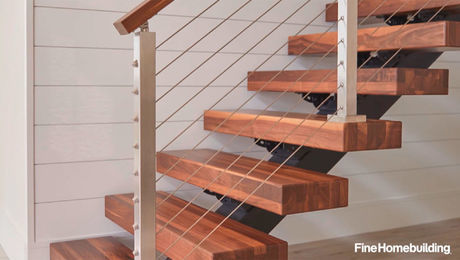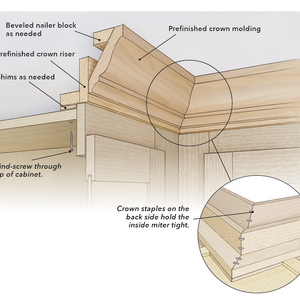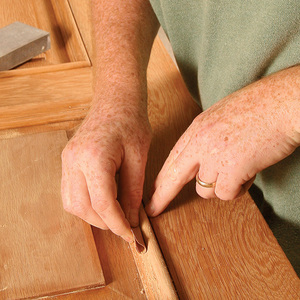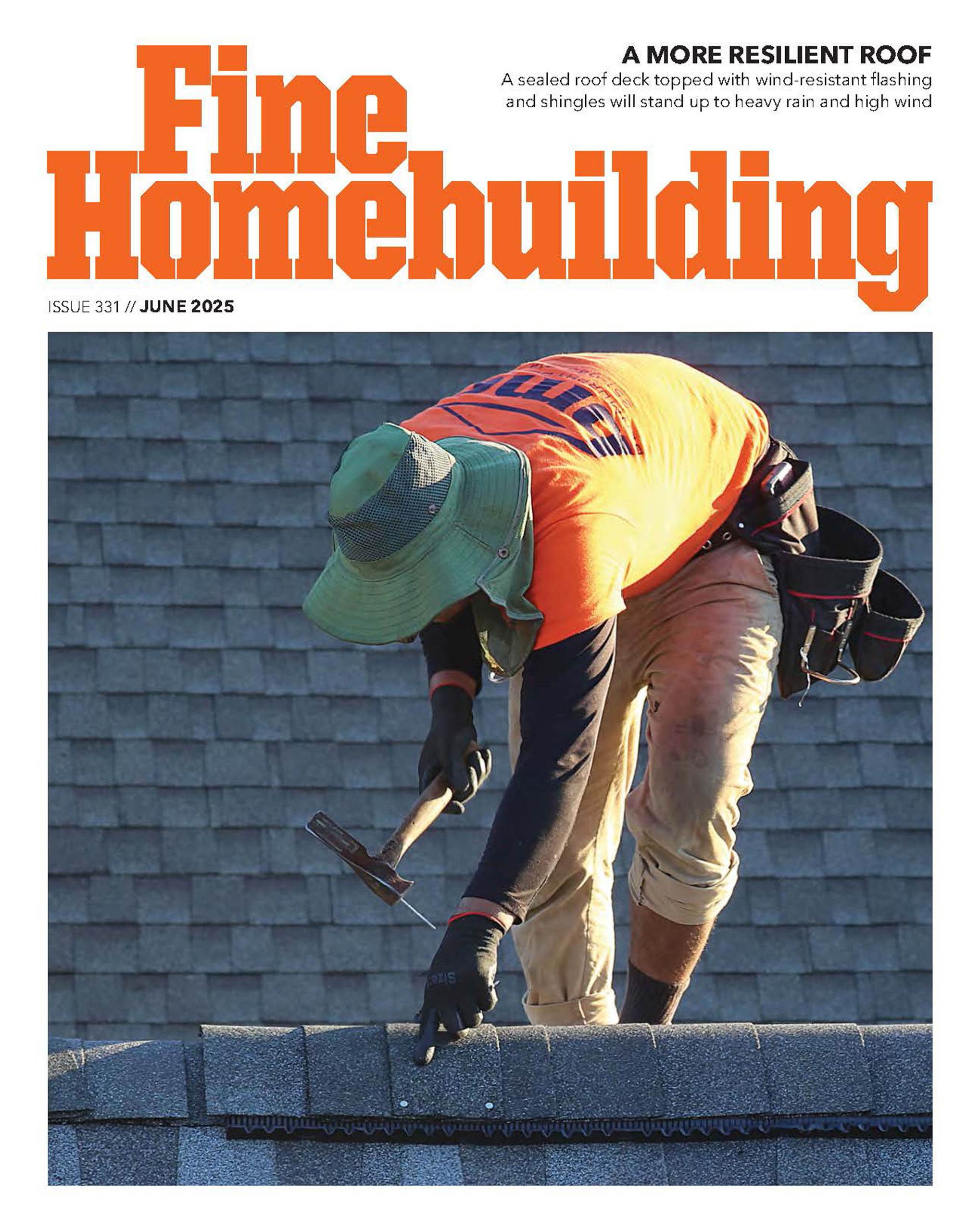I am painting my crown moulding. It is shiny white against the tannish color walls. Any suggestions on when to caulk the space between the wall/moulding gap – before painting or after painting? I think I can find white paint to match the white crown moulding if I am to caulk after crown moulding painting.
Discussion Forum
Discussion Forum
Up Next
Video Shorts
Featured Story

Listeners write in about tools and California wildfires before asking questions about rotting exteriors, leaky garage roofs, and replacing concrete basement floors.
Featured Video
Builder’s Advocate: An Interview With ViewrailHighlights
"I have learned so much thanks to the searchable articles on the FHB website. I can confidently say that I expect to be a life-long subscriber." - M.K.
Fine Homebuilding Magazine
- Home Group
- Antique Trader
- Arts & Crafts Homes
- Bank Note Reporter
- Cabin Life
- Cuisine at Home
- Fine Gardening
- Fine Woodworking
- Green Building Advisor
- Garden Gate
- Horticulture
- Keep Craft Alive
- Log Home Living
- Military Trader/Vehicles
- Numismatic News
- Numismaster
- Old Cars Weekly
- Old House Journal
- Period Homes
- Popular Woodworking
- Script
- ShopNotes
- Sports Collectors Digest
- Threads
- Timber Home Living
- Traditional Building
- Woodsmith
- World Coin News
- Writer's Digest


















Replies
I'd say same as with all trim.
prime, caulk, paint.
Jeff
Buck Construction
Artistry In Carpentry
Pittsburgh Pa
That would be my sequence. Oh yeah, make sure you use a paintable caulk.
prime then caulk then paint.
Why?
Caulk won't stick well to unsealed or unprimed wood. So you need primer first
Caulk will yellow or otherwise discolour if left exposed. So you need to paint over it.
Welcome to the
Taunton University of Knowledge FHB Campus at Breaktime.
where ...
Excellence is its own reward!
After seeing the seasonal drying shrinkage/sealant cracking this winter so far, I'm thinking of recommending that people wait a year to seal (caulk) and do the final coat of paint ...
Jeff
They're right. Prime, caulk, paint. When caulking, I like to keep a putty knife with a really square corner handy. Using that with your wet cloth--after your finger tip--as a final step in the tooling process makes great corners that help the painter to cut a razor sharp line. Too many caulk jobs end up with these gently rounded inside edges right where your trying to cut the wall paint from the crown paint.
DF,
You raise a very good point and one that has worried me about caulk reaching too far down the wall that I would end up having to paint the caulk in 2 places (upper as white and lower as beige wall color). Your suggestion is that I should keep the caulk tight in the crack so that I only have to paint the caulk once (with the crown)? Do I need to worry about matching caulk color with wall color?
I'm figuring renting a HVLP sprayer and do 2 coats after prime, caulk, then spray. I'm having to paint the baseboard separately (after the floor goes in about February). I will have to mask over again when I do the baseboard. Does overlapping this paint on some painted trims pose any problems? Thx.
I agree that it looks wrong when the caulk is built up in the corner so much that it has to be painted halfway across. This often happens with exterior caulking, but I haven't had this issue for interior caulking. I just tool the caulk with a damp finger and steady pressure to remove the excess. The resulting corner should be very close to a 90. Of course, this assumes that you're not trying to span large gaps with caulk. I would consider 1/8" a large gap.
When I paint a room with crown molding, I paint the crown before the ceiling or wall without regard to cutting a nice line. In fact, a little paint to either side is a good idea. When I paint the ceiling and wall is when I cut a straight line against the crown.
I use the brown painters tape when I caulk crown - sticky side next to the trim.
Put the tape about a 1/16" (or less) from the bottom of the crown. Smooth the caulk so that the bottom edge is very thin on the tape. Peel the tape off when the caulk is wet. Perfect, straight edge each time. The excess caulk comes off with the tape.
I like to paint the walls, install trim, prime trim, caulk, respray trim, reroll walls.
Caulk tight, best to use just enough to bridge the gap. I use a pastry bag with #2 tip.
Use white caulk against painted trim, clear agaisnt stain grade.
Happy Holidays
Beer was created so carpenters wouldn't rule the world.
Prime, paint, install, caulk/spackle, paint.
I hate brushing trim after installation, so I do as much on the horses as possible.
ALWAYS two coats of color.
Liberty = Freedom from unjust or undue governmental control.
American Heritage Dictionary
If you are going to paint the crown molding, I would prime it prior to hanging, then hang the molding. once it is hung, calk every joint, nail hole, and the whole top and bottom. use a high-end clear calk. 40year+. when you put on the calk, have a damp sponge to wipe and smooth the calk bead. when I paint crown molding, I usually paint it at a slightly higher gloss than the ceiling. lots more cutting but worth it. If you have not put up the molding yet, make sure to install a backer board so you have a continuous surface to nail into. i usually hang it with 3" decking screws. if you do not do this, you will begin to see cracks where your molding meets the wall within a year. when installing the backer board, be sure not to run it all the way to the corners. you have to leave a few inches in the corners where you will have to cope and run the molding all the way to the walls.
hope this helps and good luck.
jay
>> I think I can find white paint to match the white crown moulding if I am to caulk after crown moulding painting. << Not sure I really understand what you mean, but relize that white caulk in this kind of application always needs to be painted as it discolors over time.
Thanks for clarifying. Also, on big gaps how do you bridge this? There are also gouges, etc... The carpenter says to use Bondo. I saw that Lowes that it is an automotive product and requires mixing. Is it really the right product for fixing blown out moulding shapes of MDF material? If so, does it apply like putty that I can sand to shape after dries?
Thx.
I wouldn't use bondo for that. There are a number of different types of wood putty available at any home improvement store. Durham's rock hard is one but you have to mix it, and lately I've been using some type of Elmers stuff that is pretty easy to work with. The only time I use bonod is for special exterior repairs and to fix dents in metal doors. Bondo is kind of a PITA to work with.
Regarding calking large gaps (I assume you meant caulking) you really don't want to caulk anything much over an eight of an inch but a quarter can be caulked if it is absolutely necessary. If you must, plan on applying 2 or 3 coats of caulk. Also, in extreme cases you are actually supposed to put something called backer rod in the gap first, but I'd be surprized if you really have any gaps that big. Don't use cheap caulk. It doesn't pay in the long run.
I use DAP product 35 - 40 years. I think this should do it. For nail holes, I use the DAP product that applies on pink when wet, then dries to a white color ready to be sanded. Would this be the right way to cover the holes? Thx.
I haven't used that Dap pink putty you are talking about so I can't comment on that. I use DAP 53 painters putty on nail holes, although my painters have told me they don't like it. They use something in an orange can I forget the name - it starts with a 'C'. This kind of stuff is not really sandable though. There is a little touch to applying painter's putty, but it is not really for filling anything larger than a nail hole - as far as I'm concerned anyway...
I also use Dap Alex caulk, but it's more of a convenience as they sell it at Lowes - I have a company credit card for Lowes. It does tend to be a bid runny though - my painters use either Duron 52 yr or SW 60 yr caulk and I think it is a little thicker and better at bridging gaps.
Really at this point I think it would be best if I defer to someone else here as I don't use MDF moldings in my houses. I do know that the right painter can make it look great though...
Matt,I believe that would be Crawford's putty. The putty he is talking about that changes from pink to white is basically spackling. It works fine for nail holes and is really easy to sand.- KitTechnique is proof of your seriousness. - Wallace Stevens
Edited 12/22/2007 10:05 pm by vanderpooch
Matt
What Vanderpooch said.
They use something in an orange can I forget the name - it starts with a 'C'
Get the Crafords in the green can, sands mo better. I think the orange can is exterior, not that you can use it inside but the green can stuff sands nice.
Doug
That's good info. So the green actually dries... I found their web site - so, I guess the green is actually spackling. To the OP: like I said there is a little trick to applying the painters putty but no sanding is necessary.
Doug: Realize though that since I just do a little punch work, I rarely even use up one of those small cans of putty before it dries up or gets lost or frozen too much.
Right now I have 5 houses to punch. I just got a new thing of Dap 53 (small plastic container) and I bet I won't use even an eighth of it. BTW - I do like those plastic containers better than the cans - I think they seal better and are easier to open - no tool :-).
I like to use window glazing putty for nail holes. DAP brand.
For caulk it's Polyseamseal. Very flexible, also adhesive. Woods favorite carpenter
Matt
I may have missed something and I'm to lazy to go back and look!
The Crawfords is a spakle that you can sand very easily but if your doing punch out work I assume the painting is already done, therefore this wouldnt be my choice of filler.
As a carp I dont have to fill/prep for painting that often so I know what you mean about the can of spackle heading south before you get to use even a quarter of it.
Doug
Interiors demand so little of caulk, putty or spackle that you can probably get by using almost any product including the gimmicky (or so it seems to me) put-it-on-pink-and-turns-white-when-it-dries stuff
I use DAP Alex caulk for small gaps between moldings and wall. It will not stand up to movement as well as most exterior caulks, but I don't expect much movement between the molding and the wall.
I use Spackle brand lightweight spackle for filling small nail holes and Elmer's wood filler for large holes. I never use epoxy for interior wood filling. It's too hard to sand it. I don't know what kind of gouges you have, but I would try Wood filler first because it's reasonable sandable.
All wood fill, spackle and caulk should get a coat of paint afterwards.
You got good answers about when to caulk.
When you do caulk, pinch the end of the nozzle of the caulk tube with pliers after cutting it. That way you can get a very fine line of caulk that requires little or no wiping except in the corners.